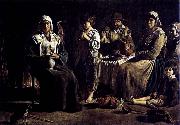Wholesale Oil Painting No Minimum |
|||||||||||
|
|
|||||||||||

|
|||||||||||
|
|
|
||||||||
Pavel Filonov1883-1941 Pavel Filonov Locations Russian painter, graphic artist and poet. He came from a working-class background; orphaned in childhood, he moved to St Petersburg, where he earned money through embroidery, house painting, restoring buildings and icons, and other tasks such as retouching photographs and making posters and wrappers for goods (a practical apprenticeship he never forgot). His interest in drawing and painting developed through copying, making portraits and the close study of human and animal anatomy. He entered the Academy of Arts, St Petersburg (1908) with difficulty but he left without graduating; his only important teacher was L. E. Dmitriyev-Kavkazsky (1849-1916), with whom he studied privately. Largely self-taught, he was a man of considerable intellectual powers. |
||||||||
|
|
||||||||
Peasant Family
Peasant Family Painting ID:: 1220 |
1915
Russian Museum, St.Petersburg 1915 Russian Museum, St.Petersburg |
|||||||
|
|
||||||||
|
|
||||||||
|
|
peasant family
peasant family Painting ID:: 56885 |
mk250 Year in 1640. Oil painting on cloth, about 112 x 158 cm. The Louvre in Paris. mk250 Year in 1640. Oil painting on cloth, about 112 x 158 cm. The Louvre in Paris. |
||||||
|
|
||||||||
Louis Le Nain1593-1648 French Louis Le Nain Gallery French family of painters. Antoine Le Nain (b Laon, c. 1600; bur Paris, 26 May 1648) and his brothers Louis Le Nain (b Laon, c. 1600; bur Paris, 24 May 1648) and Mathieu Le Nain (b Laon, c. 1607; bur Paris, 26 April 1677) lived together and shared a studio in Paris. Since the studio was headed by Antoine, he is assumed to have been older than Louis. The brothers reputation rests on a number of paintings signed Le Nain, on the basis of which other paintings (but no drawings) have also been attributed to them. None of the signed paintings bears a Christian name, and there is no secure way of attributing works to the individual brothers, although many attempts have been made. Eighteenth-century sale catalogues, fearful of anonymity, effectively chose from the three names at random. Since the writings of Witt (1910) and Jamot (1922) in particular, it has been habitual to ascribe small paintings on copper to Antoine, and austere, larger peasant scenes to Louis. This division of hands will be found in almost all the subsequent literature on the artists, although it must be stressed that there is no evidence at all to support it. Great efforts have also been made to identify works by Mathieu, since he survived his brothers by nearly 30 years and presumably continued to paint after their deaths in 1648. However, no such activity after 1648 is securely documented, and none of the surviving works bears a date later than 1647; and the arguments for a separate Mathieu oeuvre, though cogent, should not be regarded as conclusive. The outstanding feature of the work of the Le Nain brothers, and the basis of their celebrity since the mid-19th century, is the artists treatment of the poor. |
||||||||
|
|
||||||||
|
|
Peasant family
Peasant family Painting ID:: 57253 |
mk255 for in 1642. Oil painting, 1.13 x 1.59 meters. Paris, the Louvre mk255 for in 1642. Oil painting, 1.13 x 1.59 meters. Paris, the Louvre |
||||||
|
|
||||||||
|
Louis Le Nain 1593-1648 French Louis Le Nain Gallery French family of painters. Antoine Le Nain (b Laon, c. 1600; bur Paris, 26 May 1648) and his brothers Louis Le Nain (b Laon, c. 1600; bur Paris, 24 May 1648) and Mathieu Le Nain (b Laon, c. 1607; bur Paris, 26 April 1677) lived together and shared a studio in Paris. Since the studio was headed by Antoine, he is assumed to have been older than Louis. The brothers reputation rests on a number of paintings signed Le Nain, on the basis of which other paintings (but no drawings) have also been attributed to them. None of the signed paintings bears a Christian name, and there is no secure way of attributing works to the individual brothers, although many attempts have been made. Eighteenth-century sale catalogues, fearful of anonymity, effectively chose from the three names at random. Since the writings of Witt (1910) and Jamot (1922) in particular, it has been habitual to ascribe small paintings on copper to Antoine, and austere, larger peasant scenes to Louis. This division of hands will be found in almost all the subsequent literature on the artists, although it must be stressed that there is no evidence at all to support it. Great efforts have also been made to identify works by Mathieu, since he survived his brothers by nearly 30 years and presumably continued to paint after their deaths in 1648. However, no such activity after 1648 is securely documented, and none of the surviving works bears a date later than 1647; and the arguments for a separate Mathieu oeuvre, though cogent, should not be regarded as conclusive. The outstanding feature of the work of the Le Nain brothers, and the basis of their celebrity since the mid-19th century, is the artists treatment of the poor. Peasant family mk255 for in 1642. Oil painting, 1.13 x 1.59 meters. Paris, the Louvre |
||||||||
|
|
||||||||
|
Prev Next
|
||||||||
|
|
||||||||
|
Related Paintings to Louis Le Nain :. |
||||||||
|
|
||||||||
|
CONTACT US |



